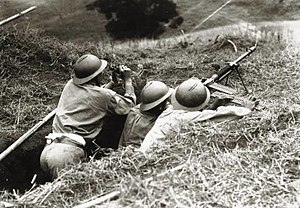Brazilian Civil War (Pax Brasiliana)
This article is incomplete because it is pending further input from participants, or it is a work-in-progress by one author. Please comment on this article's talk page to share your input, comments and questions. Note: To contribute to this article, you may need to seek help from the author(s) of this page. |
The Brazilian Civil War (Portuguese: Guerra Civil Brasileira), also known as the Brazilian Revolution (Revolução Brasileira in Portuguese), was a civil war fought in the Federal Republic of Brazil from July 1938 to August 1939. A multi-sided conflict, its main parties were the New State (Portuguese: Estado Novo), the National United Front (Portuguese: Frente Única Nacional), and the Socialist Union (Portuguese: União Socialista).
The New State was the government that had ruled Brazil since the 1932 Constitutionalist Revolution, which was crushed by Brazilian president Getúlio Vargas. As a consequence of his success in controlling the rebellious opposition, Vargas began a period of brutal oppression against his opponents and critics, establishing a proto-fascist totalitarian state. However, in 1938 Vargas was assassinated by communist partisans, who were engaged in guerrilla warfare. A power struggle between Francisco Campos and Filinto Müller emerged. Campos was the author of the 1935 constitution, which granted unlimited authority to the president and abolished the separation of powers. Müller was the head of intelligence of the New State. Campos obtained the support of the Brazilian Integralist Action, and as result, the Congress appointed Francisco Campos as the Brazilian president in May 1938.
Francisco, known by his nickname Chico Ciência due to his intellect, was unable to control the opposition. The Navy and segments of the Brazilian Army were particularly suspicious of him. In June 1938, Campos issued a decree abolishing all states, adopting a unitary model of government. This enraged the state oligarchs, who then began opposing him. In 9 July 1938, on the anniversary of the Constitutionalist Revolution, an assassination attempt on opposition leader and retired officer, Juarez Távora, was the nail in the coffin of the New State. On 19 July, Gaucho oligarch and liberal politician Joaquim Francisco de Assis Brasil declared the formation of the National League, a coalition of illegal parties that operated underground. On 23 July the city hall of the capital of Rio Grande do Sul, Porto Alegre, was occupied by the National League in a move that is considered to be the beginning of the Brazilian Civil War.
